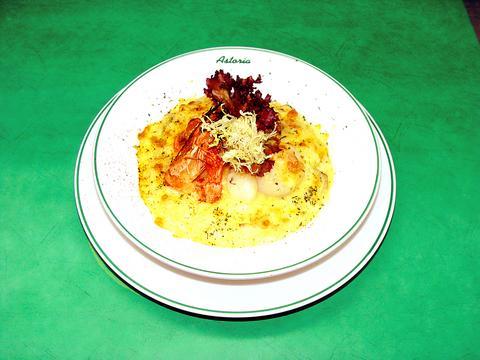A good restaurant feeds the body, but a great restaurant feeds the soul, transporting it to another place or time. The Astoria in Taipei's Wuchang Street is like a portal that takes diners back in time to 1949, to the kind of respectable cafe our Western grandmothers dressed up to lunch at. It provides a feast for the senses with its classic recipes, as well as a few new surprises.
The Astoria was reopened in July by the same family that has kept the bakery downstairs going for 55 years, to the delight of the culturati who had made the place their second home (and like family, patriarch Archiybold Chien fed some of the writers and artists in their lean years). One booth has photos of its longtime literary denizens.

PHOTO COURTESY OF THE ASTORIA
But the food stands up to the challenge of recreating a past. Four salads are offered in the mid-NT$200 price range, including a chef's salad, Russian, Caesar and fruit. The Caesar was satisfying, served with four helmeted but naked prawns. The tiny croutons, bacon and romaine were all perfectly crisp, with a dressing more sweet than redolent of garlic and anchovy.
The smoked salmon spaghetti turned out to be a handsomely made plate of fettucine topped with a wide slice of smoked salmon. Underneath were chunks of fresh salmon in a cream sauce, with a rainbow of delicately julienned peppers and onions.
The "course" menu offers fried meats and seafoods for NT$280 to NT$350. Specials (found not on the menu but on a tabletop card in Chinese only) top the price range with steak and lamb, both NT$580. They also include beef cooked in red wine for NT$380 and something that was described to me as "pancakes with cheese and vegetables" for NT$300.
This turned out to be a surprise -- a large plateful of quesadillas, served with a creamy sauce (that wasn't sour cream) and sweet salsa heady with oregano but lacking the usual smoky cumin. A slight afterburn comes from the canned jalapenos in the lighter-than-tortilla crepes, filled with chicken, cheese and julienned vegetables. You're not in the 1950s anymore. Rounding out the offerings are numerous varieties of coffee, the bakery's pastries and fruit frappes.
This is the place to take your visiting family when they've tired of noisy Chinese restaurants and want to catch their breath.

April 14 to April 20 In March 1947, Sising Katadrepan urged the government to drop the “high mountain people” (高山族) designation for Indigenous Taiwanese and refer to them as “Taiwan people” (台灣族). He considered the term derogatory, arguing that it made them sound like animals. The Taiwan Provincial Government agreed to stop using the term, stating that Indigenous Taiwanese suffered all sorts of discrimination and oppression under the Japanese and were forced to live in the mountains as outsiders to society. Now, under the new regime, they would be seen as equals, thus they should be henceforth

Last week, the the National Immigration Agency (NIA) told the legislature that more than 10,000 naturalized Taiwanese citizens from the People’s Republic of China (PRC) risked having their citizenship revoked if they failed to provide proof that they had renounced their Chinese household registration within the next three months. Renunciation is required under the Act Governing Relations Between the People of the Taiwan Area and the Mainland Area (臺灣地區與大陸地區人民關係條例), as amended in 2004, though it was only a legal requirement after 2000. Prior to that, it had been only an administrative requirement since the Nationality Act (國籍法) was established in

With over 80 works on display, this is Louise Bourgeois’ first solo show in Taiwan. Visitors are invited to traverse her world of love and hate, vengeance and acceptance, trauma and reconciliation. Dominating the entrance, the nine-foot-tall Crouching Spider (2003) greets visitors. The creature looms behind the glass facade, symbolic protector and gatekeeper to the intimate journey ahead. Bourgeois, best known for her giant spider sculptures, is one of the most influential artist of the twentieth century. Blending vulnerability and defiance through themes of sexuality, trauma and identity, her work reshaped the landscape of contemporary art with fearless honesty. “People are influenced by

The remains of this Japanese-era trail designed to protect the camphor industry make for a scenic day-hike, a fascinating overnight hike or a challenging multi-day adventure Maolin District (茂林) in Kaohsiung is well known for beautiful roadside scenery, waterfalls, the annual butterfly migration and indigenous culture. A lesser known but worthwhile destination here lies along the very top of the valley: the Liugui Security Path (六龜警備道). This relic of the Japanese era once isolated the Maolin valley from the outside world but now serves to draw tourists in. The path originally ran for about 50km, but not all of this trail is still easily walkable. The nicest section for a simple day hike is the heavily trafficked southern section above Maolin and Wanshan (萬山) villages. Remains of